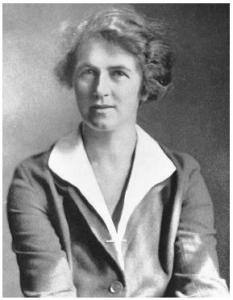Mina “Margery” Crandon (1888–November 1, 1941) grew up on a farm in Princeton, Ontario but moved to Boston as a young woman. While working as a secretary of a local church in Boston, she met and married Earl Rand, a grocer. They had one son. She later met Dr. Crandon when she entered a Dorchester, Massachusetts, hospital for an unspecified operation, possibly appendicitis. Dr. Crandon was her surgeon. She and Dr. Crandon crossed paths again later that year when Dr. Crandon served as a lieutenant commander and head of surgical staff in a New England Naval hospital during the First World War and she served as a civilian volunteer ambulance driver who transported casualties to the hospital. Mina sued for divorce from Earl P. Rand on January 1918 and became Dr. Crandon’s third wife a few months later. She moved to Dr. Crandon’s house at 10 Lime Street, with her son. Dr. Crandon later adopted her son and changed his name to John Crandon.
Crandon began experimenting with séances as a hobby, possibly to distract her older husband from a morbid obsession with mortality. On July 23, 1924 her name was submitted as a candidate for a prize offered by Scientific American magazine to any medium who could demonstrate telekinetic ability under scientific controls. With a doctor as husband, Crandon was well prepared for the challenge, and her charm and lack of interest in personal monetary reward made her seem honest to the public eye. Her séance circles included members of the middle class as well as luminary members of the Boston upper class and Ivy League elite. Famous supporters such as Sir Arthur Conan Doyle gave her significant credibility. She became so popular that her prayers were read by the U.S. Army. The Scientific American prize committee consisted of William McDougall, professor of psychology at Harvard; Harry Houdini, the famous professional magician and escape artist, who later would debunk her as a fraud; Walter Franklin Prince, American psychical researcher; Dr. Daniel Frost Comstock, who introduced technicolor to film; and Hereward Carrington, amateur magician, psychical researcher, author, and manager for the Italian medium Eusapia Palladino.
Mr. Malcolm Bird, an employee of Scientific American (not on the Prize Committee) notified Houdini of the possibility that “Margery” might win the prize. Houdini and other prize committee members attended two séances in Boston at Margery (and her husband’s) home on July 23 and 24, 1924 and claimed to have observed Crandon’s tricks. According to Houdini, Crandon had escaped control and stretched her foot to ring a bell in the séance room. Houdini told the committee about the fraud and gave a practical demonstration, however, Bird in an article for Scientific American praised Margery’s abilities and newspapers supported Bird’s declarations.
They visited again on August 23, 1924 for a few days. On the August visit, Houdini exposed the mechanics used during the séance, along with other people involved in creating the noises during the séance. Houdini asked her to wear an apparatus which prevented her from using her legs. The apparatus was a large cabinet-box leaving only her head and hands sticking out. On August 25 with Dr. Comstock and Houdini in a séance Crandon was placed in the cabinet. A box with a bell was placed on a table in front of the cabinet. During the séance the bell made a noise but when the lights were turned on it was revealed the lid of the cabinet-box had been forced open. Houdini claimed Crandon had cheated and had rung the bell herself. During the next séance Crandon requested that the sides of the cabinet be closed so she could move her hands freely inside the cabinet. A ruler was found in the cabinet, Houdini suggested that Crandon had used the ruler with her neck to ring the bell. In response, Crandon accused Houdini and his assistant Jim Collins of placing the ruler inside the cabinet to discredit her.
On August, 27 the investigator Dr. Comstock asked her to wear a similar device called a “median control.” The device consisted of a box into which Crandon and an investigator would put their feet. Connecting to the box was a board which was locked on top of the knees, preventing withdrawal of the feet. Crandon’s hands were held by the investigator and the box with the bell was placed outside the control-box. Crandon agreed to be tested and, because of the strict control, no paranormal phenomena in the séance were observed. Margery did not win the prize money.
Source: Wikipedia







